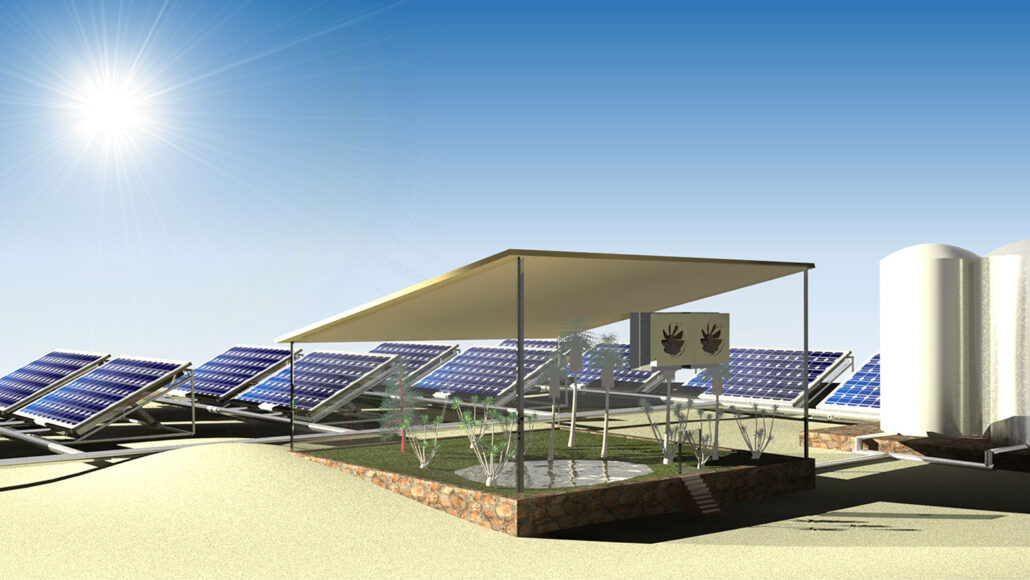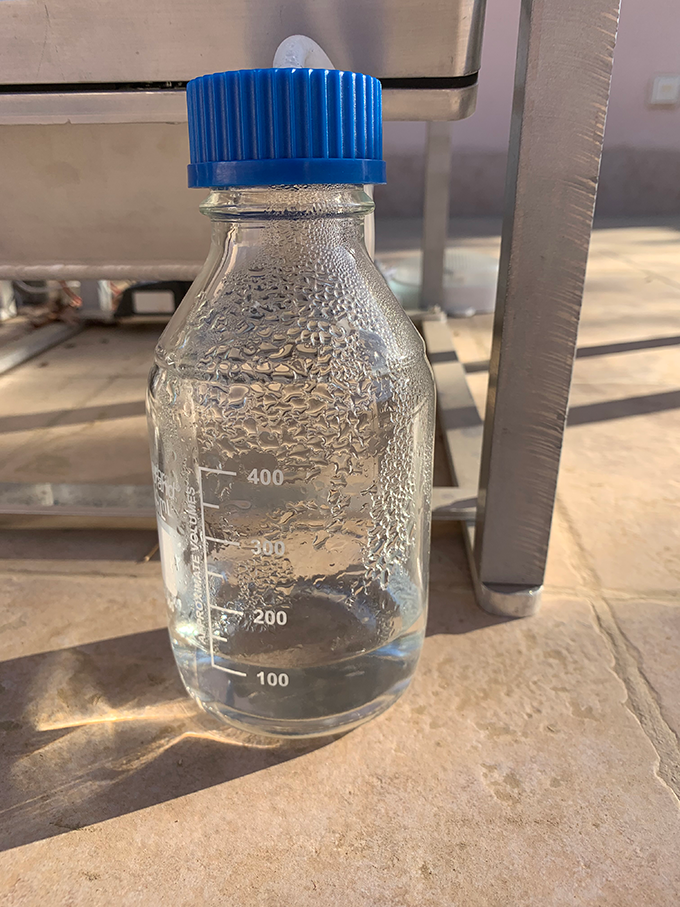This sun-powered system delivers energy as it pulls water from the air
The new machinery could offer remote and dry regions both electricity and some water for drinking or crops

This artist’s drawing shows what a new water- and energy-production system might look like. Its solar panels generate power as a water harvesting unit pulls moisture from the air. A roof shades irrigated crops from the hot sun.
R. Li et al/Cell Repts Phys. Sci. 2022 (CC BY-NC-ND 4.0)
By Laura Allen
Clean water and energy. People need both. Sadly, millions of people around the world have no reliable access to either. But a new system can provide these resources — and should work anywhere, even in remote deserts.
Peng Wang is an environmental scientist who has been spearheading the new system. His childhood inspired its development. Growing up in Western China, Wang’s home had no tap water, so his family had to fetch water from a village well. His new research could now bring water and power to regions like the one in which he grew up.
Wang works at King Abdullah University of Science and Technology, or KAUST. It’s in Thuwal, Saudi Arabia. Wang is part of a team that has been working to make solar panels more efficient. Along the way, this team has also developed a water-based gel, or hydrogel. When combined with a salt, this new hybrid material can harvest fresh water out of even seemingly dry air.
Wang’s team used solar panels to catch the sun’s rays and make electricity. They backed each of those panels with the new hybrid hydrogel. A metal chamber attached to the system stores moisture collected by the backing material. That water can be used to cool down the solar panels, allowing the panels to put out more power. Or, the water can quench the thirst of people or crops.
Wang and his colleagues tested the system under the hot Saudi sun in a three-month trial last summer. Each day, the device collected an average of 0.6 liter (2.5 cups) of water per square meter of solar panel. Each solar panel was about 2 square meters (21.5 square feet) in size. So, a family would need about two solar panels to provide the drinking water needs for each person in its household. Growing food would require even more water.
The team published its results on March 16 in Cell Reports Physical Science.
Soaking up sun — and water
Earth’s atmosphere is moist, even if it often doesn’t seem to be. The world’s air holds “six times the water in all rivers on Earth,” notes Wang. That’s a lot!
Many of the ways to tap into this water require that the air be moist, like it is in humid or foggy climates. Others run on electric power. The new KAUST system requires neither. Much like a paper towel absorbs water, its hybrid hydrogel absorbs water at night — when air is more humid and cooler — and stores it. The daytime sun that powers the solar panels also warms the hydrogel-based material. That heat drives the stored water out of the material and into the collection chamber.

The new system can run in one of two modes. In the first, it uses the moisture it collects to cool the solar panels. (Cooler panels can convert sunlight to electricity more efficiently.) Or, the collected water can be used for drinking and crops. Opening or closing a chamber under each solar panel determines how it uses its collected water.
The solar panel–cooling mode “is similar to human sweating,” explains Wang. “We sweat in order to reduce our body temperature in hot weather or when we do exercise.” The water in sweat carries away heat from our bodies as it evaporates. Likewise, the water stored on the back of the solar panels can absorb some heat from the panels as it evaporates.
This mode cooled the solar panels by up to 17 degrees Celsius (30 degrees Fahrenheit). This boosted the panels’ power output by 10 percent. In this mode, someone would need fewer solar panels to meet their power needs.
In the system’s water-collecting mode, water vapor condenses out of the hybrid hydrogel as droplets that drip into a storage chamber. This mode still boosts the solar panels’ power output, but just a little — by some 1.4 to 1.8 percent.
During last summer’s trial, Wang’s team used their device to grow a crop called water spinach. The researchers planted 60 seeds. With shade from the hot summer sun and daily water pulled from the air, almost all the seeds — 19 out of every 20 — grew into plants.
The system shows promise
“It’s an interesting project,” says Jackson Lord. He’s an environmental technologist and renewable-energy consultant with AltoVentus in San Francisco, Calif. Earlier in his career, he studied harvesting water from the air while working for X-The Moonshot Factory, based in Mountain View, Calif.
Speaking of the new system, Lord notes that it “can produce clean water anywhere.” But he thinks this type of system is better suited for making drinking water than growing food. There usually isn’t enough water in the air of dry regions to grow big fields of crops, he explains.
Still, Lord adds, it’s important to build systems like this that tap into unused resources — whether that’s drawing water from the air or harnessing excess heat to do useful work. And since the system boosts the power of a regular solar panel, he says its ability to collect water for drinking or growing crops could be thought of as a bonus to use when needed.
Wang notes that this invention is still in the early stages. He hopes to work with partners to improve the system and make it available around the world.
This is one in a series presenting news on technology and innovation, made possible with generous support from the Lemelson Foundation.







